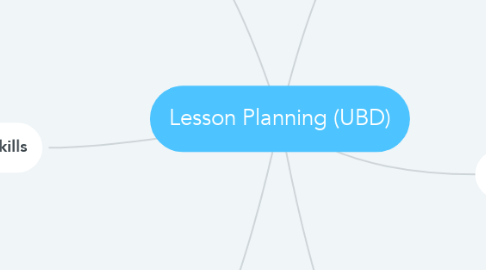
1. Facts
1.1. critical vocabulary
1.1.1. Understanding by Design (UBD)
1.1.1.1. Desired Results
1.1.1.1.1. transfer
1.1.1.1.2. Essential Questions (EQs)
1.1.1.1.3. Knowledge, Understanding, and Do (KUDs)
1.1.1.2. Evidence
1.1.1.2.1. Performance Tasks/Authentic assessments
1.1.1.3. Learning plan
1.1.1.4. UBD template
2. Concepts
2.1. Techniques to plan units/lessons
2.1.1. UBD
2.1.1.1. allows for autonomy
2.1.2. Other methods: Common Curriculum CCSS
2.1.3. Calendar, Word doc, Google doc
3. Principles & Rules
3.1. The UBD lesson-planning format helps align curriculum vertically and horizontally
3.2. The UBD lesson-planning format makes learning relevant to students
3.3. The UBD lesson-planning format deepens student understanding and transfer of knowledge
4. Interpersonal Skills
4.1. Lower School
4.1.1. Work with grade-level peers to create units
4.1.1.1. Share UBD plans for vertical and horizontal alignment
4.2. Department
4.2.1. work with department chairs to collaborate on over-arching EQs
4.2.1.1. Middle School
4.2.1.1.1. Work with grade-level content peers to collaborate on all unit UBD plans
4.2.1.2. Upper School
4.2.1.2.1. Work with grade-level content peers to collaborate on all unit UBD plans
5. Attitudes
5.1. Collaboration with peers is beneficial
5.2. UBD lesson planning is not re-creating the wheel; it is fine-tuning and clarifying instructional goals
5.3. There are resources to help you plan
5.3.1. Books
5.3.2. Blog
5.3.3. Trinity University's UBD SCWI
5.3.4. UBD Template
5.3.5. UBD Wiki
6. Procedures
6.1. 1) Identify desired results
6.1.1. identify transfer goals
6.1.2. identify essential understandings and essential questions
6.1.3. identify KUDs
6.2. 2) Determine assessment evidence
6.2.1. Develop performance task with stage 1 goals in mind
6.2.2. determine other evidence of learning (assessments) needed
6.3. 3) Plan learning experiences and instruction
6.3.1. What activities, experiences, and learning needs must take place
6.3.2. sequencing
6.3.3. opportunities for differentiation
